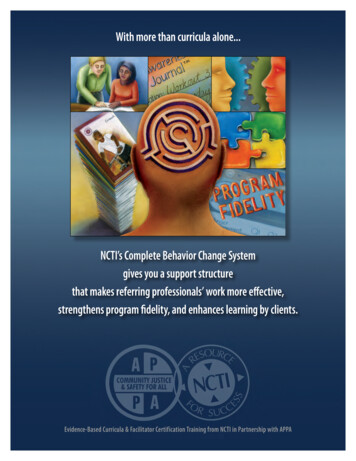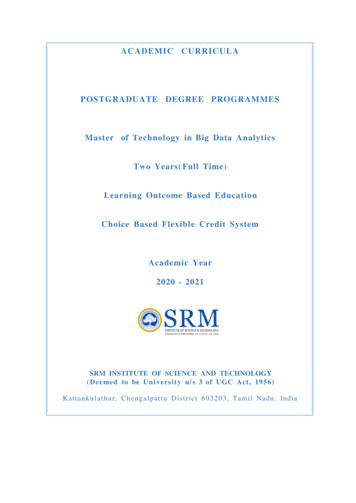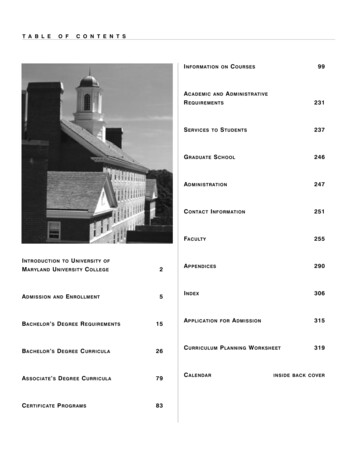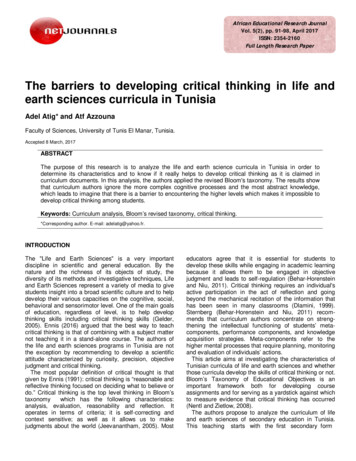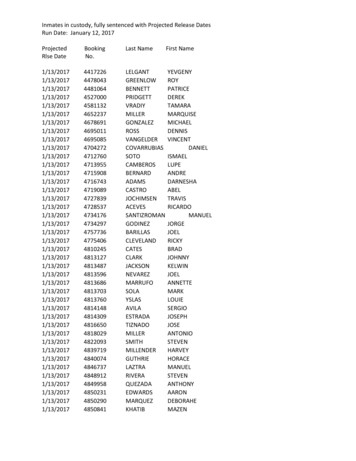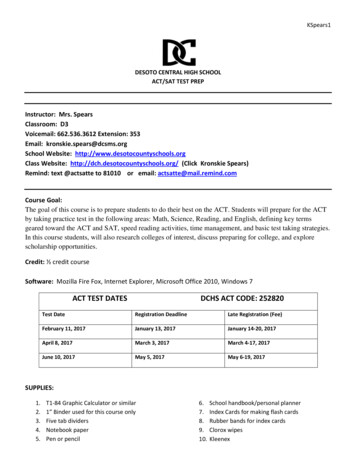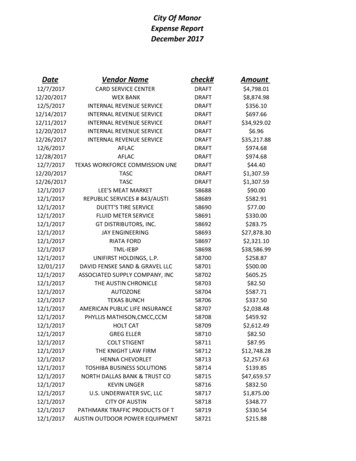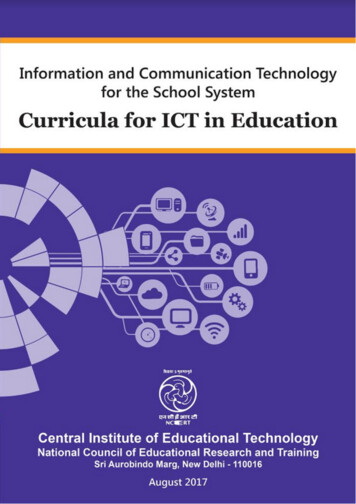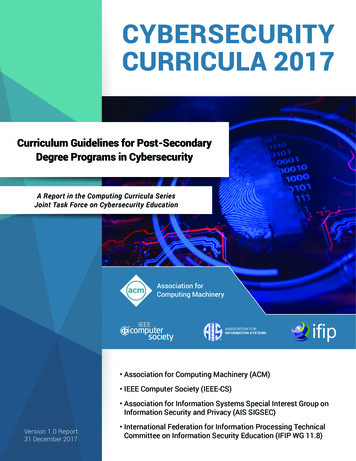
Transcription
Information TechnologyCurricula 2017IT2017A Report in the Computing Curricula SeriesTask Group on Information Technology CurriculaAssociation for Computing Machinery (ACM)IEEE Computer Society (IEEE-CS)2017 December 10Information Technology Curricula 2017Curriculum Guidelines forBaccalaureate Degree Programsin Information Technology
Information TechnologyCurricula 2017Curriculum Guidelines forBaccalaureate Degree Programsin Information TechnologyA Report in the Computing Curricula SeriesTask Group on Information Technology CurriculaAssociation for Computing Machinery (ACM)IEEE Computer Society (IEEE-CS)2017 December 10
Information Technology 2017IT2017Final Curriculum Report2017 December 10Copyright 2017 by ACM and IEEEALL RIGHTS RESERVEDCopyright and Reprint Permissions: Permission is granted to use these curriculum guidelines forthe development of educational materials and programs. Other use requires specific permission.Permission requests should be addressed to: ACM Permissions Dept. at permissions@acm.org orto the IEEE Copyrights Manager at copyrights@ieee.org.ISBN: 978-1-4503-6416-4DOI: 10.1145/3173161Web link: https://dl.acm.org/citation.cfm?id 3173161When available, you may order additional copies from:ACM Order DepartmentP.O. Box 30777New York, NY 10087-0777IEEE Computer SocietyCustomer Service Center10662 Los VaquerosP.O. Box 3014Los Alamitos, CA 90720-1314 1-800-342-6626 1-212-626-0500 (outside U.S.)orders@acm.orgTel: 1 800 272 6657Fax: 1 714 821 Sponsoring SocietiesThis report was made possible byfinancial support from the following societies:Association for Computing Machinery (ACM)IEEE Computer Society (IEEE-CS)The IT2017 Final Report has been endorsed by the Association for ComputingMachinery (ACM) and the IEEE Computer SocietyPage 2 of 163
Information Technology 2017IT2017Final Curriculum Report2017 December 10Information TechnologyCurricula 2017Final Report2017 December 10A Report in the Computing Curricula SeriesTask Group on Information Technology CurriculaAssociation for Computing Machinery (ACM)IEEE Computer Society (IEEE-CS)Page 3 of 163
Information Technology 2017IT2017Final Curriculum Report2017 December 10IT2017 Task GroupMihaela Sabin c,eUniversity of New Hampshire, USAACM and SIGITE RepresentativeHala Alrumaih eAl Imam Mohammad Ibn Saud Islamic University, Saudi ArabiaACM RepresentativeJohn Impagliazzo eHofstra University, USAACM Education Board RepresentativeBarry Lunt eBrigham Young University, USAACM and SIGITE RepresentativeMing Zhang ePeking University, ChinaACM RepresentativeBrenda Byers iProfessional and Educational Activities Board, CanadaIEEE CS RepresentativeWilliam Newhouse iNational Institute of Standards and Technology, USA; ISACAACM RepresentativeBill PatersonMount Royal University, CanadaACM and SIGITE RepresentativeSvetlana PeltsvergerKennesaw State University, USAACM RepresentativeCara TangPortland Community College, USAACM RepresentativeGerrit van der VeerACM SIGCHI; Vrije Universiteit Amsterdam, the NetherlandsACM RepresentativeBarbara Viola iViotech Solutions Inc., USA; AITPACM Representativec IT2017 Task Group Chaire IT2017 Executive Committee Memberi IT2017 Industry RepresentativePage 4 of 163
Information Technology 2017IT2017Final Curriculum Report2017 December 10ContentsExecutive Summary . 9Chapter 1: Introduction . 111.11.21.31.41.51.6Vision, Mission, and Goals . 11Overall Scope of Computing . 12Structure of the IT2017 Report . 12Guiding Principles . 13Recurring Themes and Overtones . 14Global Improvement . 15Chapter 2: The Information Technology Discipline . 162.12.22.32.42.5The Role of IT within the Computing Disciplines. 16Driving Forces through IT Innovations . 17Definition of the Information Technology Academic Discipline . 18IT Graduate Profile and Professional Readiness . 19Research in IT . 20Chapter 3: Preparing Contemporary IT Professionals . 223.1Rationale . 223.2Professional Practice. 233.3Preparing for the Global Workplace . 243.3.1 Workplace Awareness. 243.3.2 Modeling Local and Global Work Environments . 253.3.3 Administration, Faculty, and Student Roles . 263.4Incorporating Professionalism and Ethics into the Curriculum . 263.5Assessing Professional and Ethical Work. 263.6Certifications . 27Chapter 4: Competencies and Information Technology . 284.1Competency in Theory . 284.1.1 Meaning of Competency . 284.1.2 A Performance Perspective on Learning . 294.1.3 Learning Transfer . 304.2IT Competencies and Professional Practice . 31Chapter 5: Industry Perspectives on Information Technology. 335.1Overview of Industry and Information Technology . 335.1.1 The Academic Myth . 345.1.2 State of IT Skills Gap. 345.1.3 IT Job Situation . 365.2General IT Skills . 375.2.1 Soft Skills. 375.2.2 Communication Skills . 385.2.3 Teamwork Skills . 395.3Technical Skills . 395.3.1 Certification as an indicator of experience . 405.4Integrated Skills and Experiential Learning . 415.4.1 Experience, Experience, Experience. 415.4.2 Academic/Workplace Collaboration . 415.4.3 The Drive for Experience . 425.4.4 IT Industry Speaks . 43Page 5 of 163
Information Technology 2017IT20175.5Final Curriculum Report2017 December 10Next Steps . 44Chapter 6: Information Technology Curricular Framework . 466.1Structure of the IT Curricular Framework . 466.1.1 Essential and Supplemental Domains . 466.1.2 Building an IT Curriculum for an IT Degree Program. 476.1.3 Level of Learning Engagement . 486.1.4 Tags for IT Domains . 496.2Distilling the IT Curricular Framework. 496.2.1 IT Curriculum: Essential and Supplemental Domains . 496.2.2 Related Mathematics . 526.2.3 Related Science. 526.2.4 Putting It All Together . 536.3IT Domain Clusters . 536.3.1 Essential IT Domain Clusters . 546.3.2 Supplemental IT Domain Clusters. 606.4Contemporary Illustration of IT . 64Chapter 7: Implementing the IT Curricular Framework . 667.1General Requirements . 667.1.1 Communication Skills . 667.1.2 Teamwork Skills . 667.1.3 Scientific Methods . 677.1.4 Engaging in Related Areas . 677.1.5 Becoming a Contributing Member of Society . 687.2IT Curricular Framework and IT Programs. 687.2.1 Tailoring the Curriculum. 687.2.2 IT Curricula and Global Diversity . 687.3IT Curricular Models . 717.3.1 Traditional Four-year IT Programs . 717.3.2 IT Programs in Different Contexts . 717.4Strategies for Emerging Technologies . 727.4.1 Current Emerging Technologies . 737.4.2 Conceptual Emerging Technologies . 73Chapter 8: Institutional Adaptations. 748.18.28.38.48.58.68.78.8The Need for Local Adaptation . 74Principles for Curriculum Design . 74Transitions into Four-year IT Programs. 75The Need for Adequate Computing Resources . 76Attracting and Retaining Faculty Members . 77Faculty Commitment to the Degree Program . 77Information Technology Across Campus. 78Conclusion . 78Appendix A: Enterprise IT Skill Frameworks . 80A.1Competency Frameworks . 80A.2Skills Framework for the Information Age . 80A.3European Competency Framework . 81A.4The i Competency Dictionary . 83A.4.1 Task Dictionary . 84A.4.2 Task Dictionary Chart. 84A.4.3 Examples of Task Evaluation Diagnostic Level and Criteria . 85Page 6 of 163
Information Technology 2017IT2017A.4.4A.4.5A.4.6Final Curriculum Report2017 December 10Skill Dictionary . 86Skill Dictionary Chart. 86Skill Proficiency Level . 87Appendix B: Performances . 89B.1B.2Essential IT Domains. 89Supplemental IT Domains. 100Appendix C: Traditional Four-year IT Curricula Examples . 108C.1Format and Conventions . 108C.1.1 Course Time Conventions . 108C.1.2 Mapping of Information Technology Curricular Framework to a Sample Curriculum109C.1.3 Course Descriptions . 109C.2Preparation to Enter the Profession . 109C.3Curricula Commonalities. 110C.4Typical IT Curriculum – United States . 111C.4.1 Program Goals and Features . 111C.4.2 Summary of Requirements. 111C.4.3 Four-Year Model for United States Curriculum . 112C.4.4 Mapping of Information Technology Curricular Framework to United StatesCurriculum . 113C.4.5 United States Curriculum – Course Summaries. 114C.5Typical IT Curriculum – Saudi Arabia and Middle East . 116C.5.1 Program Goals and Features . 116C.5.2 Summary of Requirements. 116C.5.3 Four-Year Model for Saudi Arabia and Middle East Curriculum . 117C.5.4 Mapping of Information Technology Curricular Framework to Saudi Arabia and MiddleEast Curriculum . 118C.5.5 Saudi Arabia and Middle East Curriculum – Course Summaries. 119C.6Typical IT Curriculum – China . 122C.6.1 Program Goals and Features . 122C.6.2 Summary of Requirements. 122C.6.3 Four-Year Model for China Curriculum . 123C.6.4 Mapping of Information Technology Curricular Framework to China Curriculum . 124C.6.5 China Curriculum – Course Summaries . 125Appendix D: Information Technology in Other Contexts . 128D.1Format and Conventions . 128D.1.1 Course Time Conventions . 128D.1.2 Mapping of the information technology curricular framework to a sample blendedcurriculum. 129D.2Canadian Example . 130D.2.1 Program Goals and Features . 130D.2.2 Summary of Requirements. 130D.2.3 BCIS - Suggested Schedule 4 Years (Five courses per semester) . 131D.2.4 Mapping of BCIS to subdomains of Essential Curricular Framework . 132D.3Applied Computer Science Example . 133D.3.1 Program Goals and Features . 133D.3.2 Summary of Requirements. 133D.3.3 BAACS - Suggested Schedule 4 Years (Five courses per semester). 134D.3.4 Mapping of BAACS to subdomains of Essential Curricular Framework. 135D.4Bachelor of Business Administration in Information Security and Assurance Example 136Page 7 of 163
Information Technology 2017IT2017Final Curriculum Report2017 December 10D.4.1 Program Goals and Features . 136D.4.2 Summary of Requirements. 136D.4.3 BBA-ISA - Suggested Schedule 4 Years (Five courses per semester) . 137D.4.4 Mapping of BBA-ISA to subdomains of Essential Curricular Framework . 138D.5Three-year Baccalaureate Degree Program Example . 139D.5.1 Program Goals and Features . 139D.5.2 Summary of Requirements. 139D.5.3 General example: Typical Schedule 3 Years (Ten courses per year over six semesters)140D.5.4 Mapping of this curriculum to subdomains of Essential Curricular Framework . 141D.62 2 Baccalaureate Degree Program Example . 142D.6.1 Program Goals and Features . 142D.6.2 Summary of Requirements. 142D.6.3 General example: Typical 2 2 Schedule (Four semesters at associate degree/diplomalevel, four semesters at baccalaureate level). 143D.6.4 Mapping of this curriculum to subdomains of Essential Curricular Framework . 144D.7Design for All – A major in an ICT Curriculum . 145D.7.1 Program Goals and Features . 145D.7.2 Summary of Requirements. 145D.7.3 Suggested Schedule of the modules, as taught within a Bachelor curriculum of 3-4years 146D.7.4 Specific Competencies . 147D.8Three Years’ Bachelor of Information and Communications Technology Example . 148D.8.1 Program Goals and Features . 148D.8.2 Summary of Requirements. 148D.8.3 Typical Three-Year Schedule. 149(Ten courses per year for the first two years, and eight courses in the third year) . 149D.8.4 Mapping of this curriculum to subdomains of Essential Curricular Framework . 150D.9Australia Example - Bachelor of Information Technology . 151D.9.1 Program Goals and Features . 151D.9.2 Curricular Parameters. 151D.10 Futuristic IT Curriculum – Latin America . 154D.10.1Program Goals and Features . 154D.10.2Summary of Requirements . 154D.10.3Four-Year Model for Latin America Curriculum . 155D.10.4Mapping of IT Curricular Framework to Latin America Curriculum. 156Appendix E: Contributing Reviewers . 157References . 159Page 8 of 163
Information Technology 2017IT2017Final Curriculum Report2017 December 10Executive SummaryIn 2008, the Association for Computing Machinery (ACM) and the IEEE Computer Society (IEEE-CS) published thefirst curricular report for information technology (IT) in baccalaureate (undergraduate) programs, known as IT2008.Since that time, many new technologies have emerged and flourished, and computing education has improved theteaching and learning experiences in the classroom. In 2013, ACM formed an exploratory committee to consider anupdate to IT2008. Subsequently, they formed a task group charged with developing an update of IT2008 that wouldbe appropriately forward-looking to successfully prepare graduates in the mid-2020s. IEEE-CS joined the effort in2015. The report of the task group presented here—Information Technology Curricula 2017: Guidelines forBaccalaureate Degree Programs in Information Technology (also known as IT2017)—is the second edition of theACM/IEEE-CS curricular report for IT. Developing these guidelines for high quality, rigorous baccalaureate IT degreeprograms benefited from a comprehensive approach that engaged inter
Information Technology Curricula 2017 Information Technology Curricula 2017 IT2017 Curriculum Guidelines for Baccalaureate Degree Programs . (Five courses per semester) . 134 D.3.4 Mapping of BAACS to subdomains of Essential Curricular Framework . 135 D.4 Bachelor of Business Administration in Information Security and Assurance .
